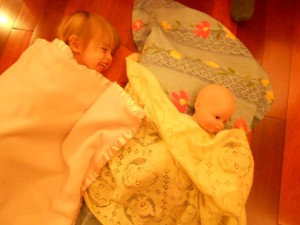The ultimate in playing with anything other than toys, is child’s play with imagination. Imaginative play not only doesn’t need toys, it can happen with nothing.
About 18 to 24 months, we can see children engaging in pretend or imaginative play. This might be talking on a phone, using a spoon to feed a stuffie, making car noises with any object, or pretending to sleep. Children’s skill in imagining continues to develop and by 3-5 years, they are creating complex stories, characters, and roles for themselves and others.
 You’ve likely heard the old advice, about the best way to eat an elephant is one bite at a time. When it comes to figuring out the world, kids can’t do it all at once. Imaginative play is one bite of what’s happening for a child. Children can pretend what it’s like to be a parent or teacher. They also pretend boss, store helper, superhero, doctor, dentist, bus driver, firefighter, and other people. Besides what’s real, kids also imagine they are animals, monsters, dragons, and fairies. Einstein explained, “Your imagination is your preview of life’s coming attractions.”
You’ve likely heard the old advice, about the best way to eat an elephant is one bite at a time. When it comes to figuring out the world, kids can’t do it all at once. Imaginative play is one bite of what’s happening for a child. Children can pretend what it’s like to be a parent or teacher. They also pretend boss, store helper, superhero, doctor, dentist, bus driver, firefighter, and other people. Besides what’s real, kids also imagine they are animals, monsters, dragons, and fairies. Einstein explained, “Your imagination is your preview of life’s coming attractions.”
 Some other words to the wise are those in the Chinese proverb, “I hear and I forget, I see and I remember, I do and I understand.” During play with imagination children are doing, not just watching or listening but actively participating. Imaginary play isn’t limited to the mind. It involves the body and the senses, feelings and emotions too.
Some other words to the wise are those in the Chinese proverb, “I hear and I forget, I see and I remember, I do and I understand.” During play with imagination children are doing, not just watching or listening but actively participating. Imaginary play isn’t limited to the mind. It involves the body and the senses, feelings and emotions too.
 There are certainly many toys that support children’s imaginative play and many non-toys. Real experiences and those in books and stories are also ways we can encourage and stimulate children’s imaginations. Kids need both opportunities to interact with others and time by themselves.
There are certainly many toys that support children’s imaginative play and many non-toys. Real experiences and those in books and stories are also ways we can encourage and stimulate children’s imaginations. Kids need both opportunities to interact with others and time by themselves.
This series of posts grew from children and April Fools. In a way, the universe seems to be playing an April Fool’s joke on us, that the way to learn about the real world is with imagination. Will play with imagination be part of your child’s day?
